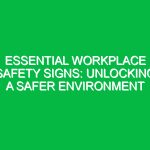Introduction
Fatigue is an often-overlooked concern in the Health, Safety, and Environment (HSE) arena, yet it plays a critical role in Workplace Safety and productivity. Working with fatigue refers to recognizing, managing, and mitigating the Effects of fatigue on employees, particularly in high-risk industries such as construction, manufacturing, and healthcare. Understanding this phenomenon is essential for organizations committed to fostering a safe work environment and promoting employee well-being.
In our fast-paced world, where the demands of work can lead to extended hours and high stress, fatigue can compromise decision-making, reaction times, and overall job performance. For instance, a construction worker experiencing fatigue may overlook crucial Safety protocols, leading to accidents and injuries. This article explores essential strategies for effectively working with fatigue to ensure HSE success, providing insights into Best Practices, regulatory considerations, and real-life applications.
The Significance of Addressing Fatigue in HSE
Fatigue can manifest in various forms—physical, mental, or emotional—each affecting performance differently. In the HSE context, the implications of fatigue are profound. Research indicates that fatigue can increase the likelihood of workplace accidents, reduce employee engagement, and hinder productivity. A study conducted by the National Institute for Occupational Safety and Health (NIOSH) found that nearly 13% of workplace injuries are related to fatigue.
Organizations must recognize that addressing fatigue is not merely a compliance issue; it is a strategic imperative. Successful HSE management hinges on the ability to maintain a workforce that is alert, engaged, and capable of performing tasks safely. The commitment to combating fatigue is not only beneficial for the organization but also for the health and well-being of employees.
Understanding the Types of Fatigue
To effectively manage fatigue, it is crucial to understand its different forms:
Physical Fatigue
Physical fatigue occurs when the body is unable to perform at its usual capacity. This can result from prolonged physical activity, inadequate rest, or excessive workload. In HSE contexts, physical fatigue can diminish strength and coordination, increasing the risk of accidents.
Mental Fatigue
Mental fatigue arises from prolonged cognitive activity, often exacerbated by stress, monotony, or insufficient mental stimulation. In industries like healthcare, where quick decision-making is paramount, mental fatigue can lead to errors that compromise patient safety.
Emotional Fatigue
Emotional fatigue, often linked to stress and burnout, can negatively impact an employee’s motivation and engagement levels. This type of fatigue is particularly relevant in high-pressure environments, such as emergency response teams, where emotional resilience is critical.
Strategies for Working with Fatigue
Managing fatigue requires a multifaceted approach that encompasses organizational policies, employee education, and individual strategies. Below are essential strategies organizations can implement:
1. Implement Fatigue Risk Management Systems (FRMS)
A comprehensive Fatigue Risk Management System (FRMS) helps organizations identify and mitigate fatigue-related risks. An FRMS typically includes:
- Data collection on employee hours, rest periods, and performance indicators.
- Risk assessment tools to evaluate the potential impact of fatigue on job performance.
- Guidelines for scheduling shifts, breaks, and time off to optimize employee alertness.
Implementing an FRMS can lead to a significant reduction in fatigue-related incidents.
2. Promote a Culture of Awareness
Creating a workplace culture that prioritizes fatigue awareness is crucial. Employees should be educated on the signs and symptoms of fatigue and encouraged to speak up about their experiences.
For instance, a manufacturing company might hold regular workshops to discuss fatigue management strategies, emphasizing the importance of sleep hygiene, nutrition, and work-life balance. When employees feel empowered to address their fatigue, they are more likely to take proactive measures to manage it.
3. Optimize Work Schedules
Work schedules play a pivotal role in managing fatigue. Organizations should strive to create schedules that allow for adequate rest and recovery. Key considerations include:
- Avoiding long shifts or back-to-back shifts whenever possible.
- Incorporating regular breaks to allow employees to recharge.
- Utilizing a rotating shift system that minimizes the impact of night shifts on circadian rhythms.
An example of successful scheduling can be seen in the aviation industry, where crew members are mandated to have specific rest periods between flights, significantly reducing fatigue-related incidents.
4. Encourage Healthy Lifestyles
Encouraging employees to adopt healthy lifestyles can combat fatigue effectively. Organizations can provide resources such as:
- Access to fitness programs or gym memberships.
- Nutritional guidance or healthy snack options in the workplace.
- Workshops focusing on stress management techniques.
For instance, a corporate office introduced a wellness program that included meditation sessions and fitness challenges. The result was not only a healthier workforce but also improved morale and productivity.
5. Monitor and Evaluate Fatigue
Continuous monitoring and evaluation are essential to understanding the effectiveness of fatigue management strategies. Organizations should establish metrics to assess fatigue levels among employees, such as:
- Surveys to gauge employee perceptions of fatigue and workload.
- Incident reporting systems that track fatigue-related accidents or near misses.
- Regular reviews of work schedules and rest periods.
Using data collected from these assessments, organizations can make informed adjustments to their fatigue management practices.
Potential Hazards and Risks Related to Fatigue
Understanding the Hazards associated with fatigue is vital for HSE success. Fatigue can lead to:
- Increased risk of accidents and injuries due to impaired judgment or slower reaction times.
- Reduced productivity leading to missed deadlines and decreased quality of work.
- Higher healthcare costs associated with fatigue-related illnesses and absenteeism.
For example, in 2017, a major oil company faced a significant incident due to fatigue among workers on a drilling rig, resulting in severe injuries and operational downtime. This incident underscored the critical need for effective fatigue management practices in high-stakes environments.
Regulations and Standards Governing Fatigue Management
Several Regulations and guidelines govern fatigue management across various industries. Key frameworks include:
1. OSHA Guidelines
The Occupational Safety and Health Administration (osha) provides guidelines emphasizing the importance of managing workplace fatigue. Employers are encouraged to assess potential fatigue risks and implement appropriate Control Measures.
2. FAA Regulations
The Federal Aviation Administration (FAA) has strict regulations regarding pilot and crew rest periods to mitigate fatigue risks in aviation. These regulations serve as a model for implementing similar protocols in other industries.
3. ISO 45001
ISO 45001 is an international standard for Occupational Health and safety management systems. It encourages organizations to proactively identify hazards, including fatigue, and establish measures to control them.
Complying with these regulations not only enhances Workplace Safety but also helps organizations avoid legal repercussions and maintain their reputations.
Conclusion
Conquering fatigue is essential for HSE success and requires a proactive, multifaceted approach. By understanding the different types of fatigue, implementing effective management strategies, and adhering to relevant regulations, organizations can foster a safer, healthier work environment.
Addressing fatigue is not just about compliance; it is about caring for employees and enhancing overall productivity. Encouraging a culture of awareness, optimizing work schedules, and promoting healthy lifestyles are critical steps toward this goal. As we continue to navigate the complexities of the modern workplace, prioritizing fatigue management will ultimately lead to healthier employees and safer workplaces.
As you reflect on the strategies outlined in this article, consider how your organization can take meaningful steps toward effectively working with fatigue. The well-being of your employees and the safety of your workplace depend on it.


